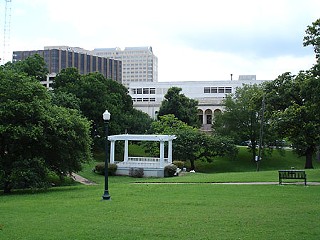Developing Stories
Wooldridge Square Park: The Study
By Katherine Gregor, Fri., Aug. 3, 2007

Trivia quiz: Lyndon Baines Johnson announced his bid for the presidency there. It's named after the mayor of Austin from 1909 to 1919. Shaped like a giant bowl, it was once a city dump. If you've visited lately, it was probably to hear a symphony concert, play giant chess, attend a political rally, or receive/serve a meal for the homeless.
Wooldridge Square Park (the right answer) was one of the original four public squares designated on the 1839 plat of the city of Austin. Like its remaining historic sisters Republic Square and Brush Square, Wooldridge Square has a way to go to realize its potential as a dynamic people place. The good news: To lay the groundwork for a much-needed reinvigoration of the park, a comprehensive study of Wooldridge Square was completed in June by a team from the University of Texas School of Architecture, sponsored by the Downtown Austin Alliance. The study (www.downtownaustin.com/living/recreation/#parks) was conducted by professors Louise Harpman and Jason Sowell (who donated their time) and graduate research assistant Brett Koenig (paid by a DAA grant), in the spirit of engaging with Austin. It documents Wooldridge Square's history and historical uses, as well as current conditions, needs, challenges, and opportunities. Publicly presented with a lively panel discussion to a full-house crowd at a June DAA Issues and Eggs breakfast, the study provides a launching ground for fresh public engagement with the park.
Indeed, all three historic squares now are receiving increased attention from the DAA and the Austin Parks Foundation, with the support of the city's Parks and Recreation Department. The UT team noted that, "Wooldridge Square has a rich history as a performance and gathering space," but the park "faces many challenges that hinder it from fulfilling its full potential as a dynamic urban enclave." After serving ingloriously as a city dump for frontier Austin's first 70 years, the 1.75-acre block finally was developed as a park in 1909 and named for its champion, Mayor A.P. Wooldridge (who lived in one of the homes that surrounded it). "Among his many improvements was a pond system constructed along the brook that was then running through the park," notes the UT study. The Greek Revival pavilion was completed in 1910 (the current pavilion is the third incarnation) and regularly used for public oration, concerts, and political events. Until about 1930, it hosted Friday night concerts; today they continue on summer Sunday nights at 7:30pm. (This Sunday, Aug. 5, it's a big-band concert of Count Basie and Duke Ellington tunes. Bring the family and a picnic to this free concert.)
Lending the park stature are its architectural neighbors, notes the study. The Austin History Center, a 1933 Texas Historic Landmark on the National Register of Historic Places, is on the south side across Ninth Street, and the 1930 art deco Travis County Courthouse is on the north side. Unfortunately, uses to the east and west fail to enliven the perimeter of the park. Across Guadalupe is a drive-through bank and a parking garage; on the San Antonio Street side is a county parking garage.
The UT/DAA study concludes with three recommendations:
• Engage all Downtown stakeholders with Wooldridge Square, as an integral part of the Downtown fabric, within the context of the forthcoming Downtown Austin Plan. What the park most needs is a Friends of Wooldridge Square group committed to working on its behalf. A major stakeholder should be Travis County, with its adjacent courthouse and related facilities. New mixed-use development on the east and west sides of the park could greatly help to populate it, but intergovernmental politics and Capitol-view corridor restrictions will make that challenging.
• Program events year-round, both day and night, to create a dynamic people space that attracts a variety of groups. To honor and extend Wooldridge's historic traditions, the park regularly could host contemporary visual and performing-arts performances and political events. Ginny Sanders, executive director of First Night Austin, envisions a series of political speeches at Wooldridge on topics such as public transportation, global warming, sustainability, and volunteerism -- to get people engaged in public issues as well as the park.
• Create and implement a plan for improving the landscape, site architecture, and amenities. The study includes national examples of well-designed amenities sensitively added to small, urban parks, such as expanded pavilions and eateries. Needed physical improvements at Wooldridge include an irrigation system, lighting for night use, and new park furniture. Expanded programming will require stronger maintenance, as well. But the bowl-shaped terrain and American Disability Act accessibility requirements pose special, expensive challenges. A mandate to preserve the beautiful, mature trees nixes the possibility of leveling out the park.
The next challenge is money, of course. While PARD has estimated Wooldridge Square needs about $500,000 in improvements, it has no such funds in its budget. Parkland dedication fees -- now due from all residential development Downtown -- could help fund future improvements. But the park also needs community and corporate support, and the DAA and Austin Parks Foundation will be shaking the can.
Studying Wooldridge pointed out the need for a Downtown parks master plan, to comprehensively plan the highest and best uses of all three historic squares and neglected Palm Park; the DAA's Parks Committee is currently pricing and pursuing that master plan. A similar UT/DAA site study for Brush Square is also under way.
Got something to say on the subject? Send a letter to the editor.








